Whether it’s strolling through the palatial gardens in Vienna, hiking to the top of a historic fortress in Germany, taking a leisurely bicycle ride in the countryside, or lazing about on the deck while your boat sails through the heart of Budapest — we’ve rounded up the top things you need to do, eat, see, shop for, and experience in central Europe.
Treat yourself to an action-packed escapade, or indulge in life’s finer things. This list is ideal for the curious, wanderlusting traveler. Our handpicked recommendations will get you to Europe’s most stunning architectural gems, skyline views, shopping corners, off-the-beaten path hikes, and in-the-know coffee shops (your Insta-story will thank you later).
So if you’re just starting to dream of a trip to the Netherlands, Germany, Austria and Hungary or just need a few last minute pointers, we have you covered. These are the experiences you’ll remember forever.
Why take a European River Cruise?
Tour buses and trains can only get you so far in Europe, and they certainly can’t sail directly through the heart of the beautiful country — just as the ancient traders, poets, and sailors did.
One of the most remarkable and historic ways to travel Europe is via river cruise. Drift through the deep-ravined canyons of the Rhine Gorge, cruising past fairytale like castles and medieval villages, and sail alongside the stone terraces of the Danube River’s pristine wine country.
If you want to travel through the cultural veins of central Europe: this is the journey for you. There are a few options when deciding who to sail with, but we recommend Viking Cruises.
The Viking Grand European Tour
The once-in-a-lifetime 15-day Viking Grand European Tour begins in one of the hottest destinations in Europe right now: the colorful, art nouveau treasure trove of Budapest.
From there, you glide along Austria’s cultural gems like Melk and Vienna, and wander east into Germany, drifting through the caste-laden Rhine Valley. The trip wraps up along the historic golden canals of Amsterdam.
Aside from all the WONDERFUL cultural and historic cities, castles, and waterfronts you get to see, the innovative Scandinavian-designed ships are packed with amenities and staff who go out of their way to make your experience better.
The large windows offer panoramic views and the modern, sleek (and small by cruise standards) ships surprised us with their elegance.
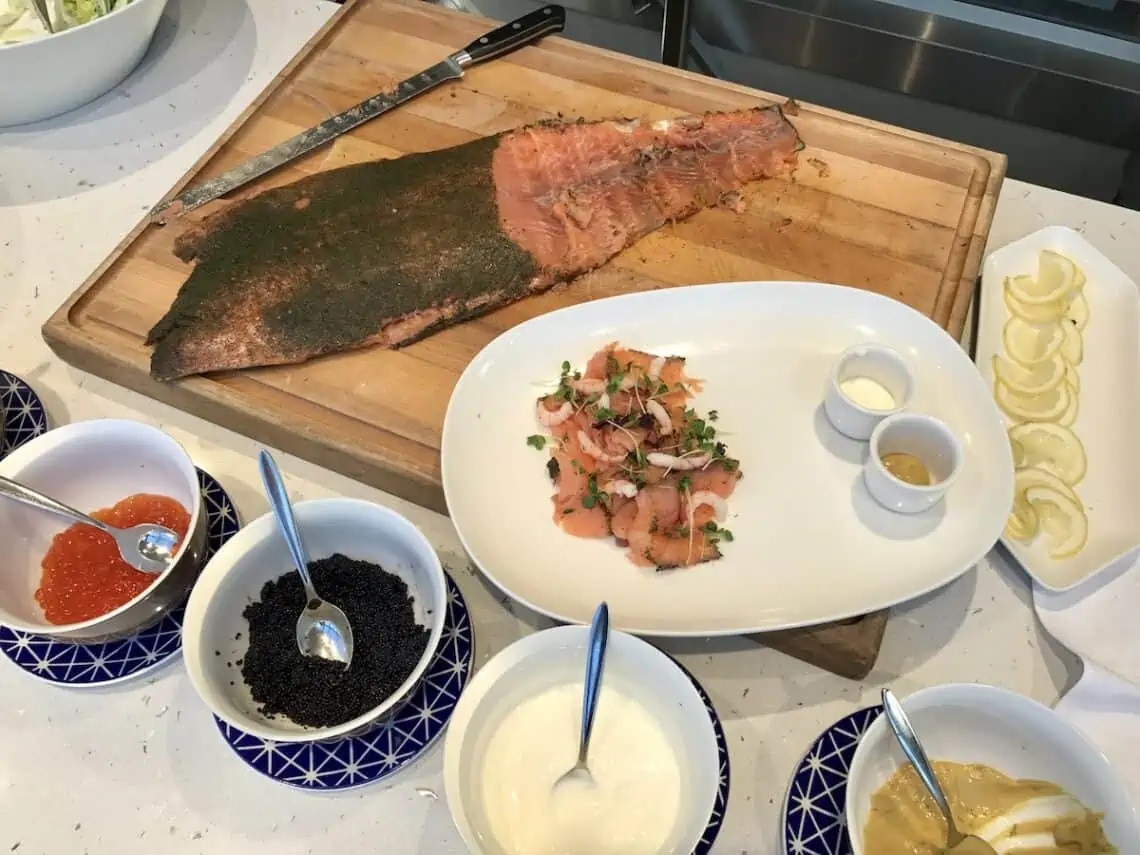
Some of our favorite moments were watching the sunset on the 360-degree sundeck, participating in some healthy competition in the library or lounge, and making new friends at dinner (which was delicious and had great a variety of choices to complement our port destinations plus complimentary beer and wine!).
While the 6+ person per table seating was intimidating at first, we ended up making lifelong friends and having wonderful dinner conversations each night. We actually really looked forward to the evening chats with our new friends.
Side Note: There was also an herb garden and solar panel system onboard — good to know that this small, stylish, but understated fleet was making more sustainable decisions.
Continue reading to discover some of our favorite experiences along the way!
Budapest
Dubbed the “Paris of the East,” Budapest (pronounced boo-dah-peh-sht) is a true cultural gem.
Whether you want to shop for a porcelain tea set in the markets, try a traditional paprika-seasoned goulash, take a relaxing dip in the thermal baths, or discover the eclectic beauty of the city’s Art Nouveau architecture, this explorer’s paradise will win your heart.
Embark on a Panoramic Walking Tour of the City
One of the best ways to explore the nooks and crannies of Budapest is on foot. Take a walking tour to get the local insight or create your own itinerary.

Whatever you do, make sure you stop by the Matthias Church (more commonly known as the location of the Fisherman’s Bastion), a 14th century gothic church where many of Hungary’s kings have been coronated and buried. The church, if you can believe it, is even more stunning at night.
You’ll also want to take a picture in front of the impressive Chain Bridge, the first permanent stone bridge to join Buda and Pest (made with iron chains!).
Hősök tere (aka Heroes’ Square) is also another stomping point you’ll want to hit (if only for the people watching alone): it’s Budapest’s most impressive square and gathering point.
If you have time afterwards, stroll through city park Városliget, just behind the square or steal a peak of the Vajdahunyad Castle.
Soak in a Thermal Bath
One of the most iconic experiences you can have is to treat yourself to a dip in one of Budapest’s iconic thermal baths. The baths are one of the city’s defining cultural and architectural gems.
Make a morning or afternoon of it so you can kick back and relax in the earth-drawn mineral waters (and be sure to explore the maze of saunas, steam rooms, and heated pools that are attached!).
One of the reasons the Romans settled in Budapest was because of the local geothermal springs, so you can soak up some history in the city of spas. Book a Thermal Spa Tour with Viking Cruises, or explore the Széchenyi spa complex or lesser known Király baths on your own!
Indulge in the Local Treats
Sample the uber fruity alcoholic Pálinka (made with plums, apricots, and pears), or reward yourself with some traditional marzipan Hungarian confectioneries at Szamos Cafe right in town.
Vienna
Coffee-house culture and imperial architecture set the scene here. Sprinkle in the impressive musical heritage of the city — once home to musical masterminds like Beethoven, Mozart, Brahms, among many others — and you have a truly magical city for exploring.
Stroll through the Magical Gardens at the Medieval Schönbrunn Palace
Get a taste for Austria’s imperial monarchy at the UNESCO World Heritage site Schönbrunn Palace (a 1141 room wonderland), and then spend even more time exploring the decadent gardens that surround it. Get lost in a hedge maze, or spend time admiring the exquisite flower beds.
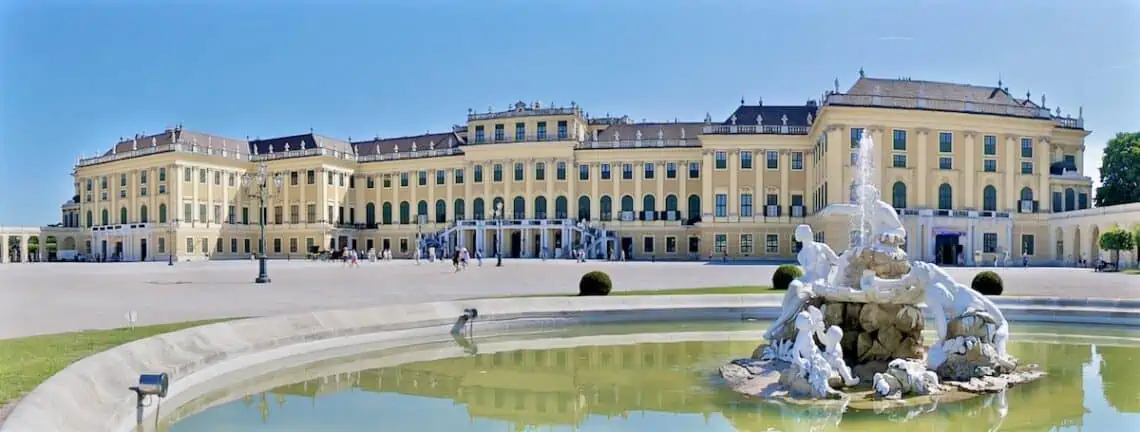
I spent about 4 hours and walked 7 miles within the gardens alone! It turned me into a hot, sweaty mess but I made it up the hill to the gorgeous Gloriette which stands opposite to the palace.
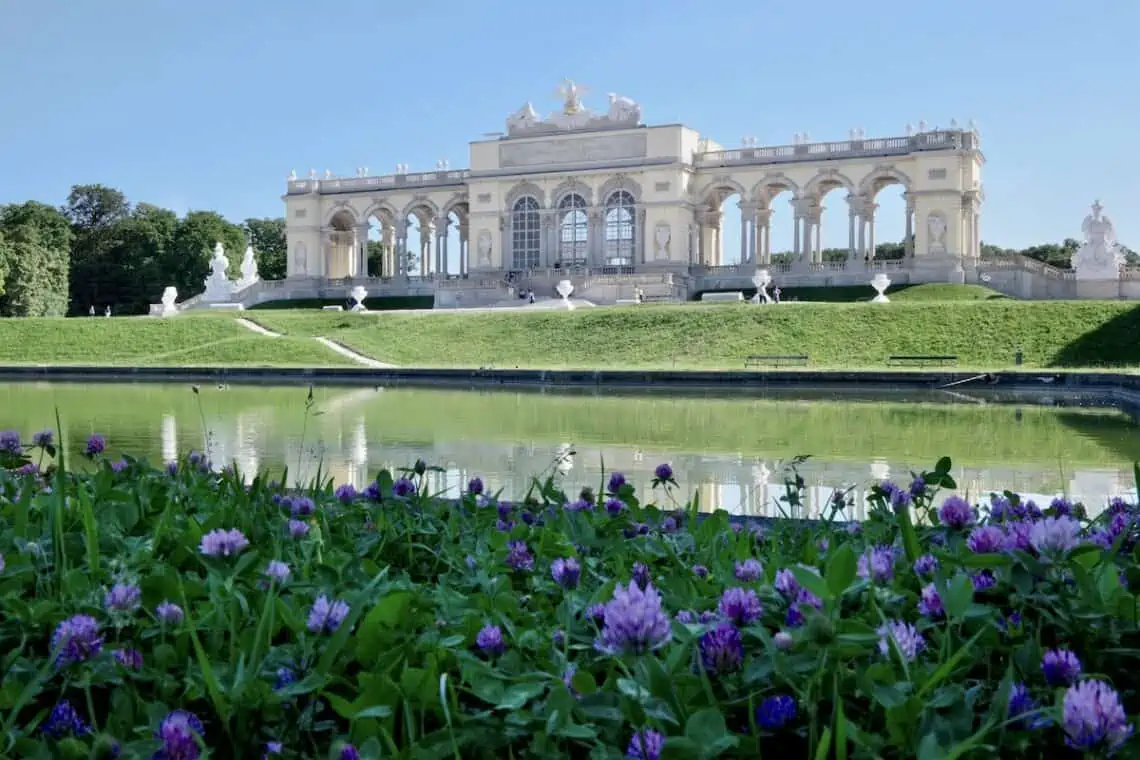
It is the largest in the world and was used as a dining and festival hall for Emperor Franz Joseph I. It’s totally worth the hike for the views of Vienna and is a great spot for a picnic. If you go, definitely plan to spend at least half the day there.
Tip: There is a public restroom just to the right of the Gloriette. (Bring a 50-cent Euro piece for entry.)
Visit the Castle-like St. Francis of Assisi Church
This glorious, red-roofed church looks like a Disneyland castle, and is definitely worth a visit for the photo alone. Walk along the Reichsbrucke to see it from all angles and get an incredible photo.
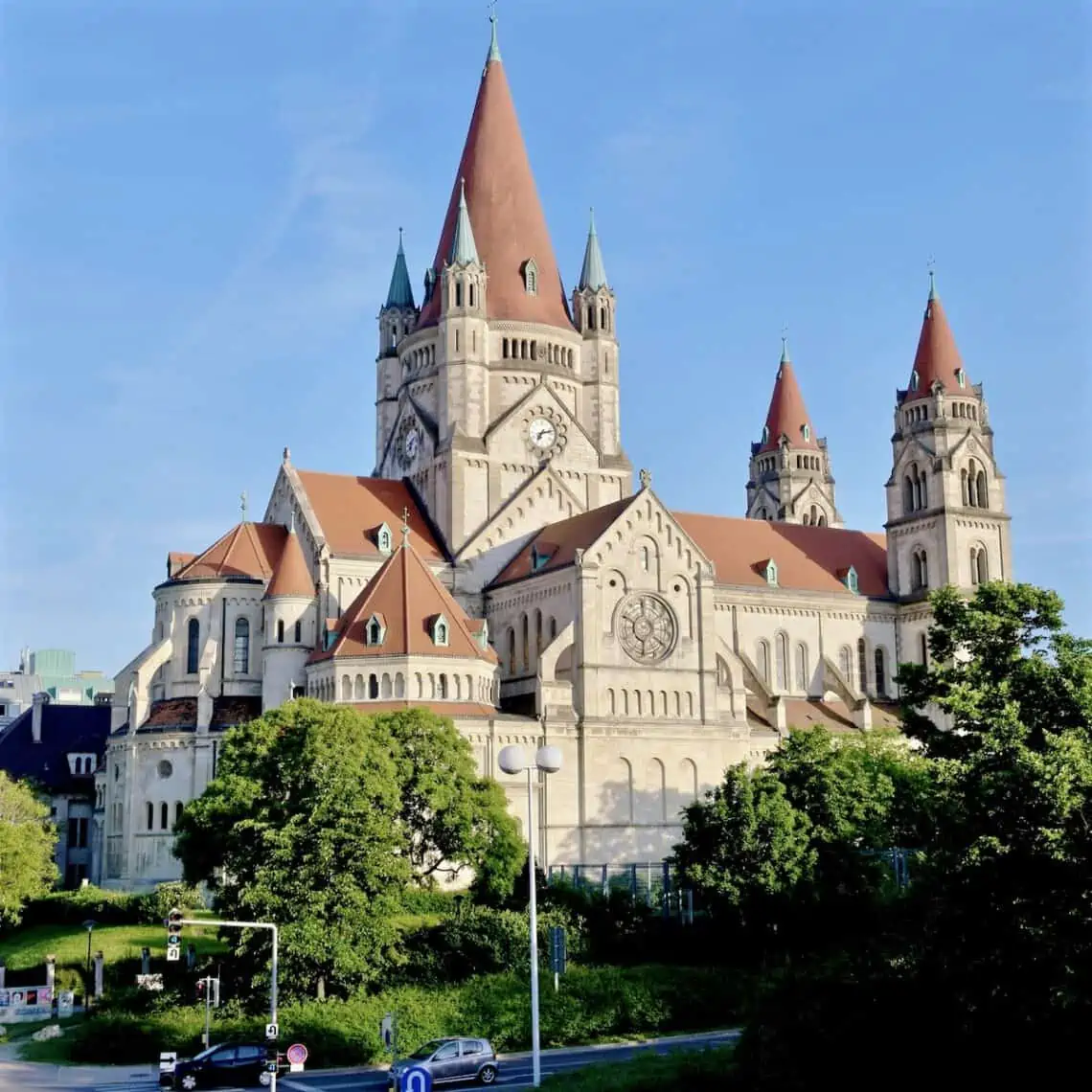
Check out the Art Nouveau-style Elisabethkapelle (Elizabeth Chapel) to the left of the church and admire the beautiful gold ceilings from the inside.
Sip on a Einspänner
Before you leave, you have to try this Viennese espresso specialty! It’s a double espresso topped with whipped cream and typically accompanied by a small chocolate. You’ll get bonus-in-the-know traveler points for ordering this!
For an art nouveau vibe, check out the glamorous Cafe Landtmann, a coffee-house living room with elegant cakes and Austrian delicacies.
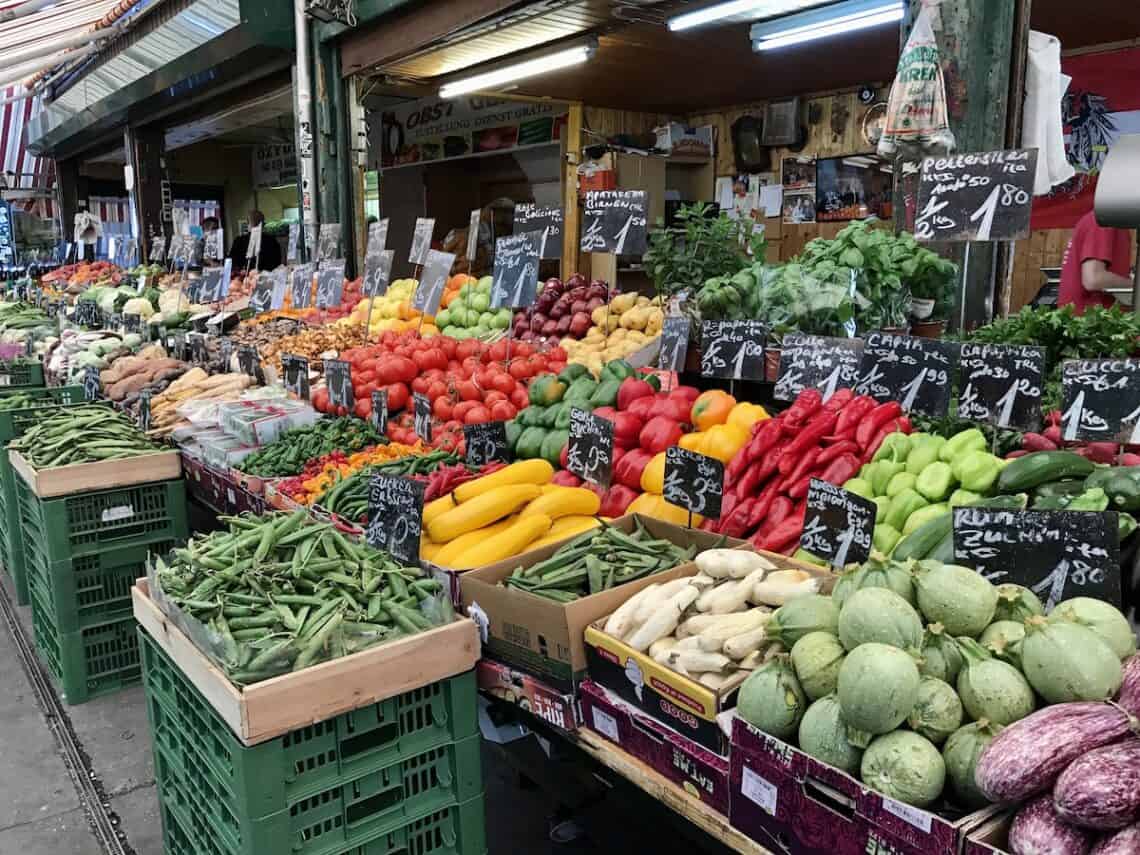
If you are still looking for an adventure, or need to walk off some cake head to the Naschmarkt, to peruse stand after stand of fresh veggies and produce.
Melk
Nestled on the banks of the grand Danube River and located just a quarter-hour’s drive from the Austrian countryside, this picturesque river-valley town charms visitors year-round with its abbey, cobbled streets, and old-world delights.
Visit the Melk Benedictine Abbey Church
The restored abbey, perched high above the Danube River, is one of the main reasons tourists flock to Melk.
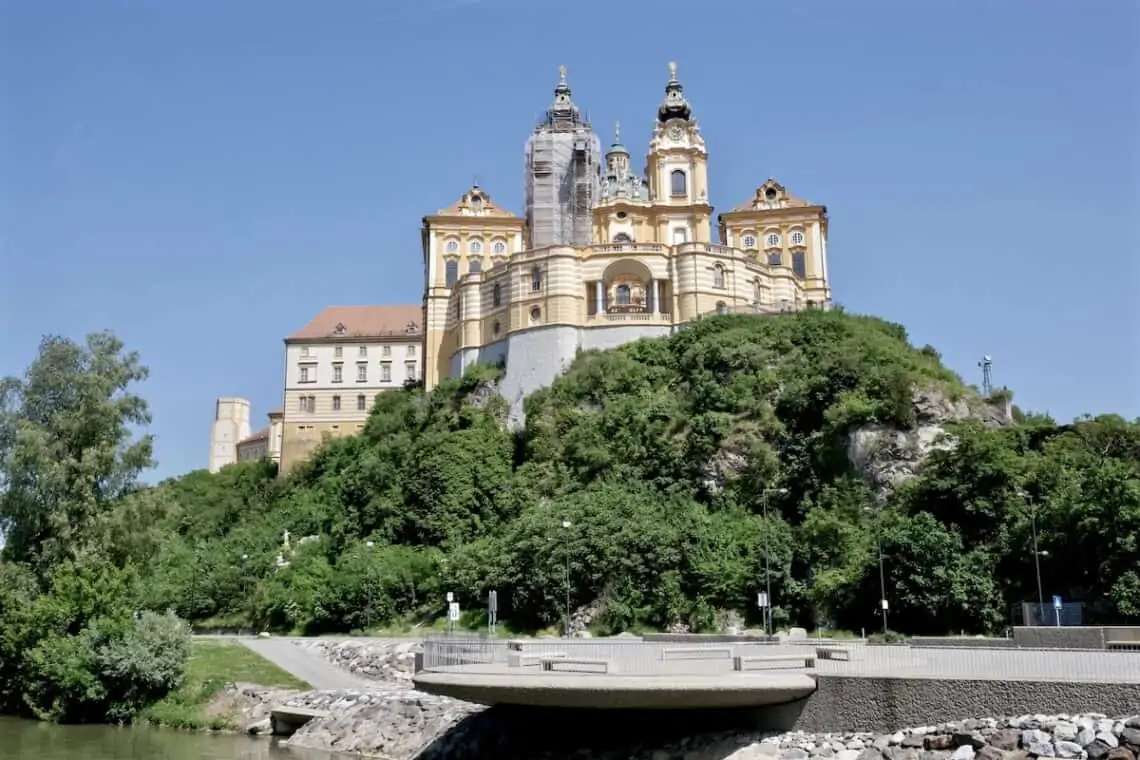
Designated as a UNESCO World Heritage site, the abbey was originally built as a stopover point for the Emperor of Austria as he made his way down the river. Today, this abbey and church is considered to be the finest Baroque church north of the Alps.
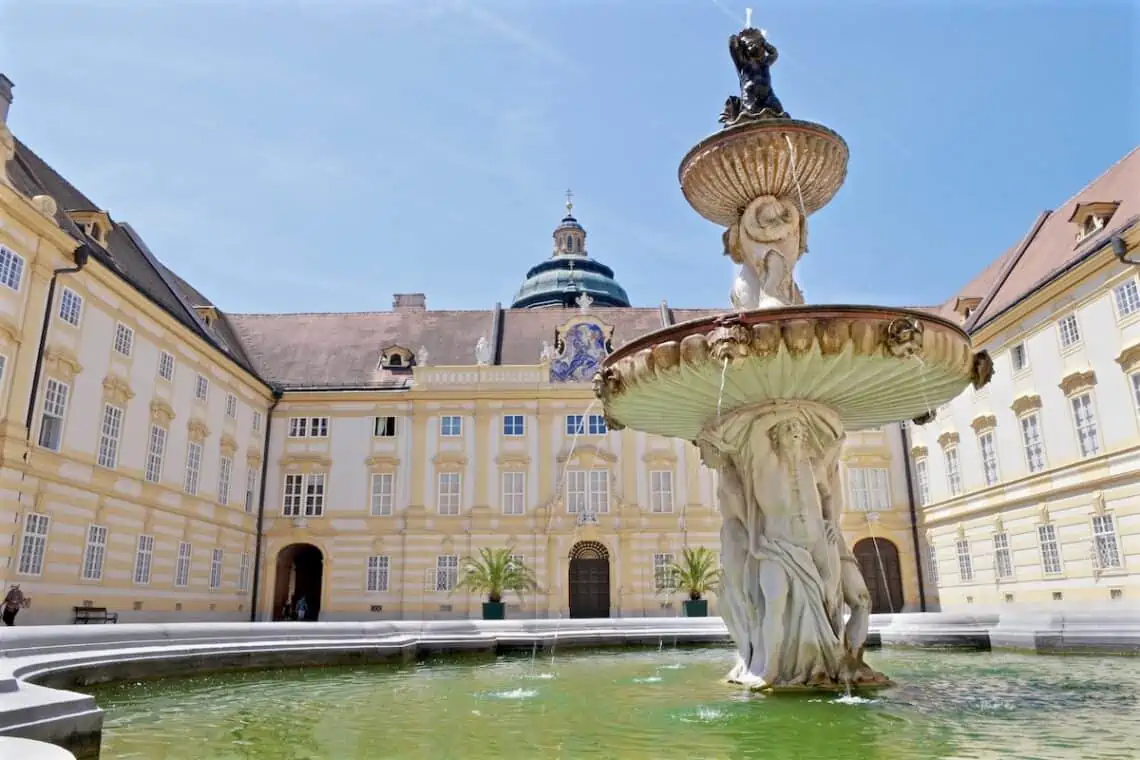
Explore the stunning imperial rooms, marble halls, ancient treasure chests, painted ceilings, exquisite libraries, and the lavish church. After you’ve walked the grounds (and paid a visit to the Baroque Garden Pavilion) finish up in the park and grab an espresso at the abbey’s iconic Stiftrestaurant.
Hot tip: If you are fortunate enough to visit during one of the organ recitals, make sure you stick around to listen. It’s a sound you’ll never forget.
Get Your Bike On
The stretch between Melk and Krems is one of the most popular biking routes for cyclists in all of Europe. Bike alongside the castle-laden river towns, peddle past old farms, forests, and postcard worthy homes.
Stop for ice-cream and lunch in the old world cafes or push through till the end. This enjoyable 40km bike is doable for both families or expert cyclists, and anyone in between!
Hike in Jauerling Wachau Nature Park
If you’re visiting in the spring, summer, or fall the nearby nature park offers exceptional hiking trails. Marvel at the looming mountains and wander through old growth forests. It’s only a 20 minute ride from town, and you can learn more about the trails here.
Passau
Positioned at meeting point of three distinct rivers (the Danube, Inn and Ilz), this German town is appropriately nicknamed the City of Three Rivers.
Whether you want to see Europe’s largest pipe organ, take a leisurely teatime in town, learn about the trading history of Bohemian salts, or capture a fantastic view from Veste Oberhaus, this postcard-perfect pastel town awaits.
Veste Oberhaus
Built wayyy back in 1219, Veste Oberhaus is a delightful fortress that has served Passau’s bishop princes over the years.
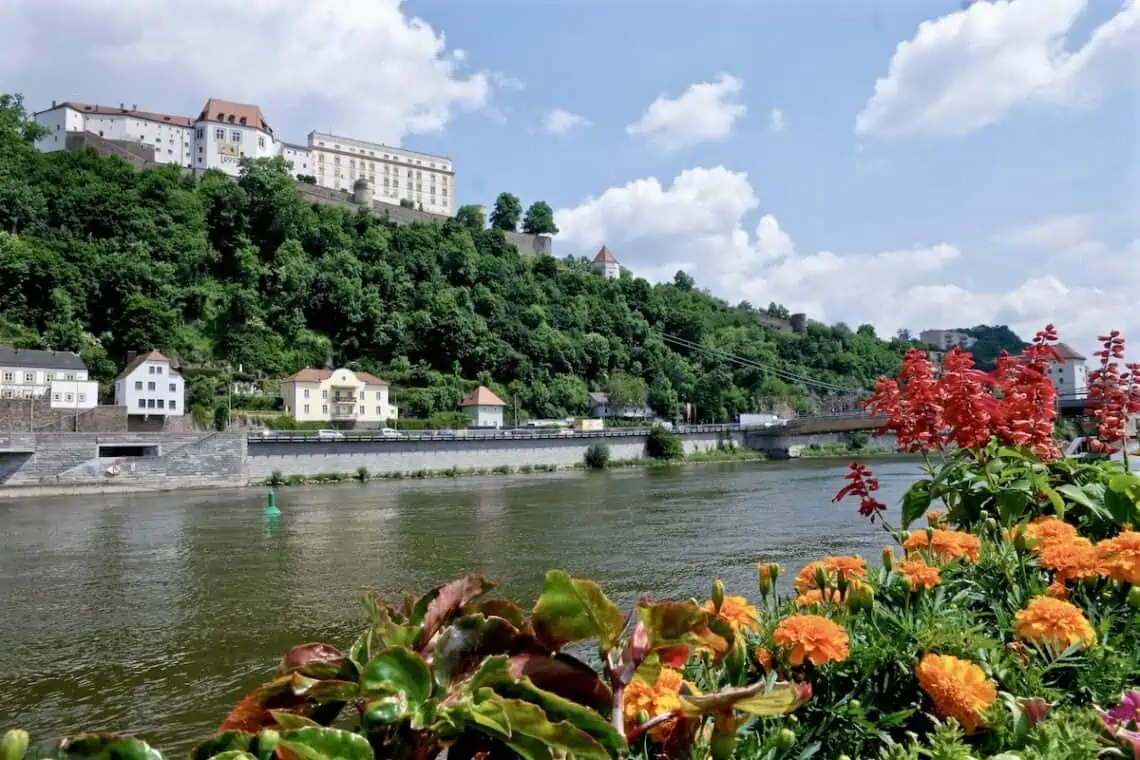
Nestled high on the mountain crest of St. Georgsberg, the fortress was originally constructed as a display of power against local independent rebel groups. Since it’s construction, it has been attacked four times but never successfully.
Pay a visit to get the best views in town, learn about the importance of salt trading in Passau at the museum, and grab a bite to eat at Das Oberhaus, the onsite restaurant.
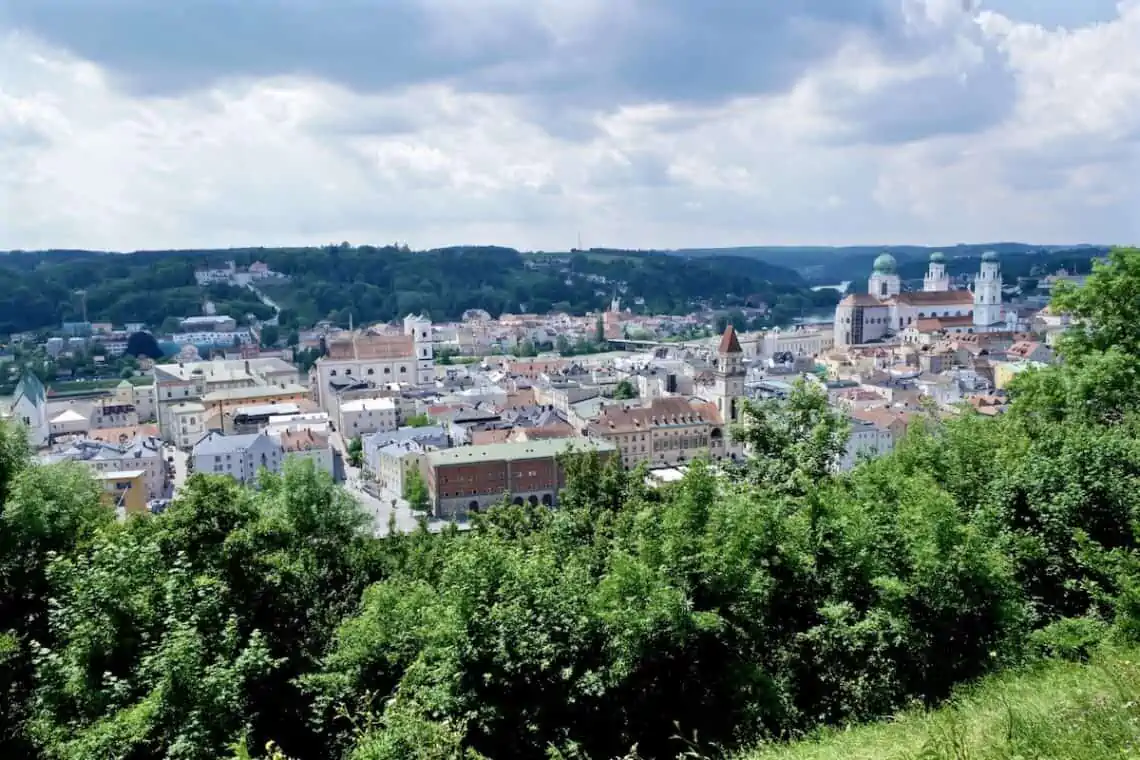
You can hike to the top (prepare to get sweaty!) or take the museum shuttle bus from the main square. The hike is totally worth it.
Embark on a Bavarian Cruise & Visit the Baroque Town of Schärding
This half-day Viking excursion is a great way to see an off-the-beaten path town and travel at a more leisurely pace. Cruise along the peaceful Inn River waters and wind your way through the rolling green countryside.
Straddling the border of Germany and Austria, this wooden barge cruise is simply quaint — and if you’re there during colder months you can cuddle up in the cozy onboard blankets.
Once in Schärding, your guide will lead you on a walking tour of the charming pastel buildings, churches, and quirky alleys, giving you a sense of the history and place, and then you’ll wrap up with a hot salted pretzel and cold beer.
It doesn’t get much better than this small-world Bavarian tour.
Pick up some Gingerbread
If the cobblestone streets and delightful churches don’t win you over, the gingerbread surely will. Be sure to stop in one of the many and confectionery shops selling heavenly-smelling gingerbread. We recommend Cafe Simon.
Regensberg
If Medieval history is your jam, look no further than this German gem. Back during the days of the Holy Empire, the region’s most powerful men gathered here. Today, this UNESCO designated city is living history.
Split in half by the iconic Danube River, Regensberg balances it’s old trading prowess with its new-fangled university vibe. Explore the tangle of cobblestone streets or geek out on the region’s trading history here.
Explore St. Peter’s Cathedral
Regarded as one of the most stunning examples of Gothic architecture in Bavaria, St. Peter’s Cathedral charms visitors with intricate details, otherworldly stained-glass windows, silver alters, and massive towers.
Visitors will notice Roman details as well. The Cathedral is 279 feet long and the twin towers soar nearly 350 feet high (dominating the Regensberg skyline). Try to catch an organ concert here, it’s pretty spectacular!
Hot Tip: Bring a lock to seal your love forever with the thousands of other Love Locks found on one of the pedestrian bridges that cross the Danube nearby.
Visit Alte Würstküche (The Old Sausage Kitchen)
A trip to Germany wouldn’t be complete without a visit to the oldest sausage kitchen in Europe. Alte Würstküche has been serving up mouth-watering sausages for the past 850 years!
Pair a slice of sausage with their secret mustard recipe or sample some homemade sauerkraut, and you’ll be in heaven. Take your food to go and enjoy it on a park bench by the Danube River!
Hot tip: Mustard tastings happen daily at 2pm!
Hot, Hot Tip: You can visit both the Cathedral and the Sausage Kitchen on the Viking Walking tour that is included with the cruise!
Grab a Coffee
Because modern-day Regensberg is home to a bustling University population, there are a number of uber trendy (and bookish) cafes that you should hit up when visiting!
Try Cafe Prinzess, the oldest coffee shop in Germany, or explore on your own, you really can’t go wrong.
Nuremberg
Known for its bustling energy and vibrant nightlife, Nuremberg is the second largest city in Bavaria (after Munich) and was once an unofficial capital of the Holy Roman Empire. It was also a cornerstone of Nazi Propaganda and the place of punishment for Nazi war criminals.
Whether you want to visit the ruins of Zeppelin Field, the Nazi parade grounds of the 1930s, see the Palace of Justice, explore site of the infamous Nuremberg Trials, or grab a beer in town, there is plenty to enjoy and explore here.
Nuremberg & World War II Tour
Travel to the ruins of Zeppelin Field, a site where 100,000 plus soldiers saluted Hitler, pass through the documentation center, and then venture to Courtroom 600 in Justizpalast, where high-ranking Nazis stood trial and were brought to justice between 1945 and 1949.
The contrast of the sites and histories is mind blowing, and the guided tour provides an incredibly accurate, yet disturbing depiction of our world history.
This optional extension tour is a historic must when visiting Nuremberg. The tour finishes with an opportunity to shop in market square or explore the city’s charming half-timbered houses!
See the World’s Oldest Globe at the Germanisches National Museum
With over 22,000 exhibits, the Germanisches National Museum is a treasure trove of German History. It is home to the largest collection of cultural history in the german-speaking region, and is also an architectural masterpiece (a collision of Bavarian architecture and modern renovations).
Stop by to see the world’s oldest surviving globe, Rembrandt’s famed Wide-Eyed Self-Portrait, Albrecht Dürer’s portrait of his mother, Lucas Cranach the Elder’s portrait of Martin Luther, and Dürer’s rhinoceros.
Get Your Christmas Shopping Done Early at Handwerkerhof
If you need a break from the castles and history tours, pop by this local market. Located by the old city wall– just a short stroll from the Central Square, Handwekerhof, is an artisan market, packed with homemade wonders like coconut cookies, Lebkuchnerei Nuremberg Gingerbread, and honey from the imperial forest.
Take home a curved rolling pin, a traditional glass-blown ornament, and celebrate with a dark dunkel beer!
Bamberg
Built by archbishops on seven hills, Bamberg is a romantic ode to Medieval architecture and is home to a delightful collection of Germany’s best breweries. Comprised of three districts: the episcopal town, the island town and the market gardener’s town, there are a wealth of secret spots to discover.
Explore the narrow streets of this UNESCO world heritage city, and get lost in the maze of wandering allies. Be sure to try the world-famous smoked beer while you’re at it too!
Visit the Old Town Hall
Constructed in 1386, the Old Town Hall rests proudly on an artificial island in the middle of the river Regnitz. Legend has it that the old bishop of Bamberg did not grant the citizens any land of their own to build a town hall. So naturally, the citizens rallied and built an artificial island in the middle of the river to make room for a town hall.
This building is an amazing achievement and gives off a fairy-tale vibe. Photographs simply do not do it justice. Stop inside to see the epic porcelain collection. If you are looking for a bit more structure and education, try the walking tour!
Take a Romantic Stroll in “Little Venice” (self walk)
Formerly known as the fisherman’s district, the quaint half-timbered houses and gardens are the perfect setting for an afternoon stroll. Walk along the rows of medieval riverside homes and photograph the tiny hanging pot gardens, and anchored boats that border the river.
The best place to take a photograph is across the street on the narrow Am Leinritt road. Continue to the bridge at Markustrabbe for some amazing views of riverside homes.
Hot Tip: Walk the back alleyways for a self tour of stunning old wooden doors
Grab a Smoked Beer!
Bamberg boasts the world’s densest concentration of breweries. Pay a visit to Schlenkerla, a brewpub where you can sip one of Bamberg’s famous smoked beers (and some grub if you’re hungry too).
It can be quite busy here, with lines spilling out onto the streets in the summer, but the rustic charm and authentic german experience are worth the trip.
Wurzburg
Located at the epicenter of the German wine region, Wurzburg, is a small German town that delights visitors with its baroque architecture and delicious wines. Dotted with castles, vineyards, and a lively university scene, this riverside town is a charming respite.
Explore Wurzburg Bishop’s Residence
Step back in time as you wander through the glorious and ornate rooms at the UNESCO World Heritage Bishop’s Residence.
Regarded as one of the finest palaces in all of Europe, discover massive grand staircase, the imperial hall, mirror cabinet or ogle at the charm of the blue drawing room, the warmth of the yellow living room or the corner chamber on an included guided tour with Viking.
The Wurzburg Bishops’ Residence boasts the largest ceiling fresco in the world. Unfortunately no pictures are allowed inside, but that only adds to the spectacular mystery and appeal.
Head to the modern, Cafe Lenz for some of their popular homemade lemonade afterwards.
Do as the Locals Do — Sip Wine on the Main Bridge
Head on over to Alte Mainbrücke (the Main Bridge), where you’ll find locals and tourists enjoying the region’s famous wines while overlooking the water and admiring the statues of saints.
There are several bars along the side of the river that sell wines by the glass, and a few that sell wines in bottles. Then head to Cafe Wunschlos (located in a sneaky back alley) for delicious coffee and cakes.
Koblenz
Known as the place where rivers and mountains converge, Koblenz, Germany is a haven for historians, nature lovers, and vineyard hoppers. Cruise the UNESCO listed world heritage site along the river and bask in the unspoiled scenery.
Because three mountain ranges converge here, the Koblenz region is ideal for summer hiking and the steep slopes give way to exceptional wines. Explore the castles, historic battle sites, and escape into the mountains for some well-needed detox time.
Castle Hopping: Visit the Marksburg Castle
Renowned as the best-preserved castle in the Rhine Valley, this fortress is a historic masterpiece. Designed to protect farmland and families from invading outlaws, this never-destroyed architectural wonder boasts ancient cannons, mysterious staircases, wine cellars, halls, apartments, chapels, and residential quarters.
It’s easy to visualize living here back in the day and the intelligent design, makes it a joy to explore. It’s no wonder this place is the only Rhine Castle that was never destroyed! This tour is included with Viking Cruises, or you can head over on your own!
Interesting Fact: Japan offered 250M Deutsche Marks to purchase the Marksburg Castle but Germany refused!
Sample a Riesling along the Scenic Mosel River
Home to nearly half a million vines, Koblenz has long been one of Germany’s famous wine-countries. Head out to the terraced vineyards along the Mosel River for a relaxing afternoon of wine-tasting.
Due to the cold climate and steep slopes, the region is world-renowned for their dry rieslings. Between the views of the Eiffel mountains and the golden honey-petrol wines, you can’t go wrong. Reserve your space here or explore the wine region on your own!
Pick up a Sweet Treat
The Germans are good at their sweets. Opt for a Lebkuchen, Kaiserschmarrn (a caramelized pancake topped with a plum and iced sugar compote) at breakfast or stick with a Kirsch tart!
Wertheim
With a population of just under 24,000 residents, Wertheim is the small-town german stop you’ve been waiting for. Step off the boat and wander through a fairy-tale world of charming german bakeries, artisan shops, and boutique stores.
Stop by Wertheimer Glaskunst
Admire traditional German glass-blowing techniques during a demonstration onboard the ship, and then stop by the glorious Glaskunst, a family-owned glassblowing shop in town.
Already in their 7th generation of glassblowers, the Ittig family pioneered the glassblowing industry in Germany, creating tools and techniques that are now standards around the world.
Stop by the shop in town to see the exquisite hand-blown bowls, beads, paperweights, and legendary sparrows. Pick up his famous Sparrow of Ulm as a souvenir!
Bite into the Best Pretzel of Your Life
Don’t be shy about pretzel sampling, head on over to the Fritz Frischmuth Bakery for a culinary wonder that will rock your world. This family-owned bakery has been churning out delicious, soft salted pretzels for 13th generations and has perfected the art!
Visit the Wertheim Castle
Germany is known for its dramatic castles and this one does not disappoint. Located about 15 minutes uphill (a steep walk from the center of town), this landmark attraction is one of the most picturesque ruins in the country.
Enjoy incredible views at the top, stay for a meal or drink in the restaurant, or join the guided walking tour for the secret tidbits of knowledge that only the local guides know.
Cologne
The landscapes of Germany are bewitching, and the colorful cityscape of Cologne is no exception. If you like chocolate, sports, Roman history, a good beer, a popping party scene, or beautiful medieval churches, this vibrant city might be just what you’re looking for.
Cologne Cathedral
Famous for its dual spires, elegant stained glass windows, and the shrine of the three kings (rumored to contain the remains of the three wise men), the Cologne Cathedral will blow your mind.
Now the single most visited attraction in all of Germany, this artistic masterpiece took seven centuries to complete (YES 700 YEARS) and it was well worth the time. Admire the black alter, the colorful windows, and intricate details: but stay for the shrine of the three kings. This is where it is all at.
If you splurge on one thing on the trip, let it be the Top of Cologne Tour offered by Viking. It’s absolutely stunning and not many do it!
The best part about this backstage tour is that is led by a local guide who is also part of the Dom’s excavation and restoration crew — meaning you’ll get all the tips and insider secrets, and visit the roof — a hidden city gem with stellar views.
Visit the Belgian Quarter or Ehrenfeld for Your Dose of Hipster Charm
To feed your inner hipster, head to the Belgian quarter. Located between Aachener Straße in the south and Friesenplatz in the northeast, this ultra trendy neighborhood boasts some of Germany’s trendiest cafes, theaters, live music venues, and bars.
But if you want to be truly in the know, rumor has it among the cool young-folk, that Ehrenfeld is slowly taking over as the hipster stronghold, though it is still very much in a transition phase. Keep your eyes peeled for the stunning murals!
In the Belgian Quarter stop by Café Belgique for quiche and a cup of joe, and if you’re up for a true off-the-beaten path adventure check out Café Sehnsucht a bio-cafe and slow food restaurant in Ehrenfeld.
Do as the Locals Do and Order a Kölsch
Kölsch is the beer of choice in Cologne. It’s a straw-colored fermented beer made from Pilsener Malts. Be sure to try one while you are in the metropolitan center of Cologne, and order a Halve Hahn (rye bread and gouda cheese to go with) at Brauerei Päffgen in the heart of the city.
Hot Tip: Kölsch is always served in small .2 liter glasses. The waiters will keep refilling your glass until you put a coaster on top, so watch out (or let it flow!)
Ready to Cruise?
The most remarkable and historic way to travel Europe is via boat. Drift through the deep-ravined canyons of the Rhine Gorge, cruise past fairytale like castles and medieval villages, luxuriate in a thermal bath, and sail alongside the stone terraces of the Danube River’s pristine wine country.